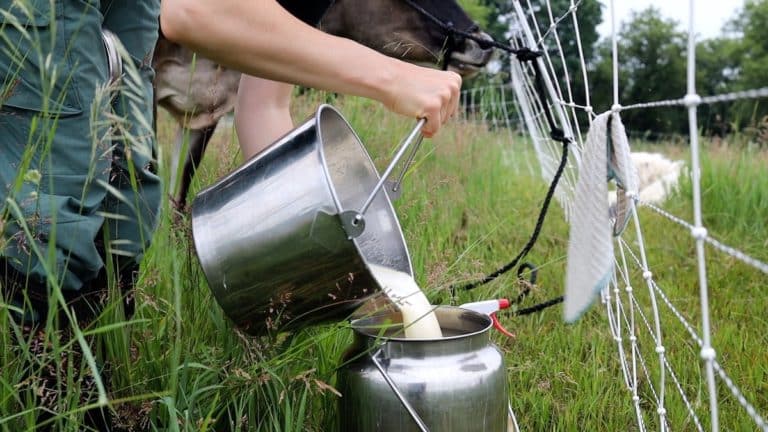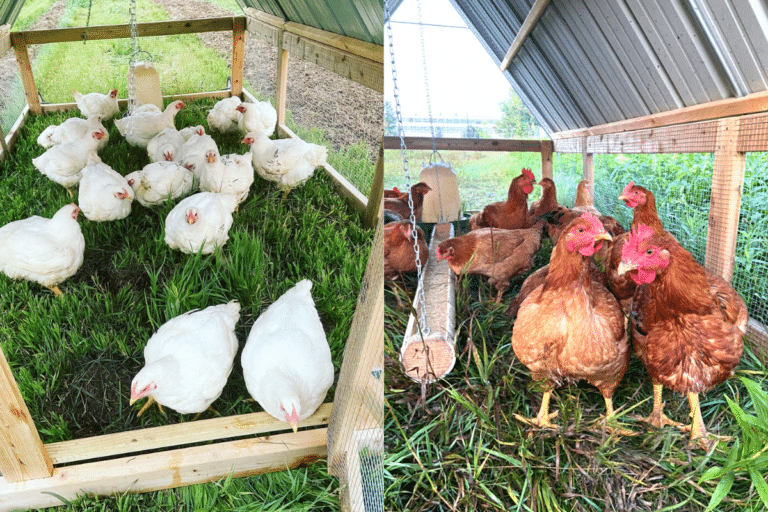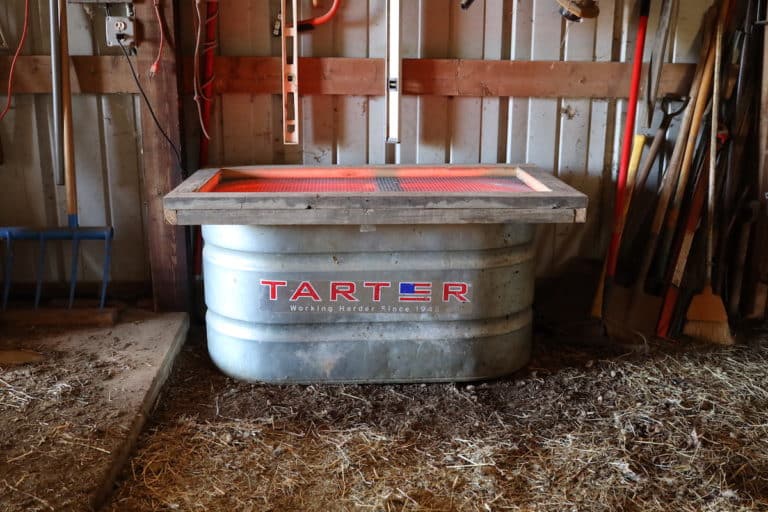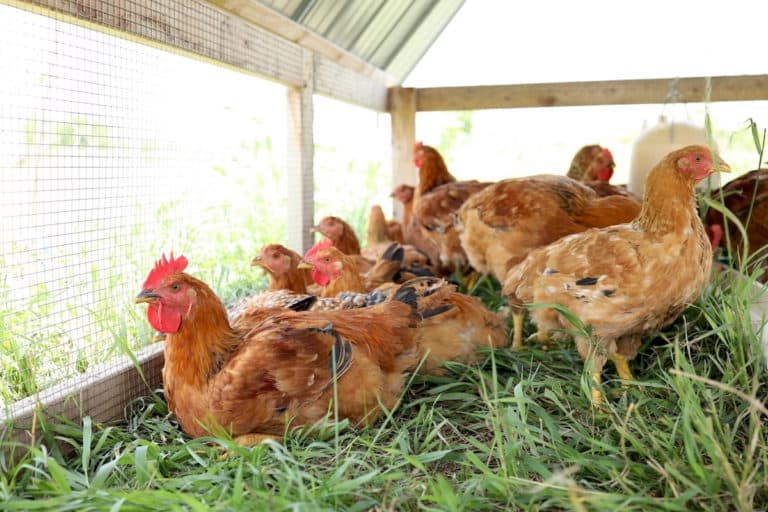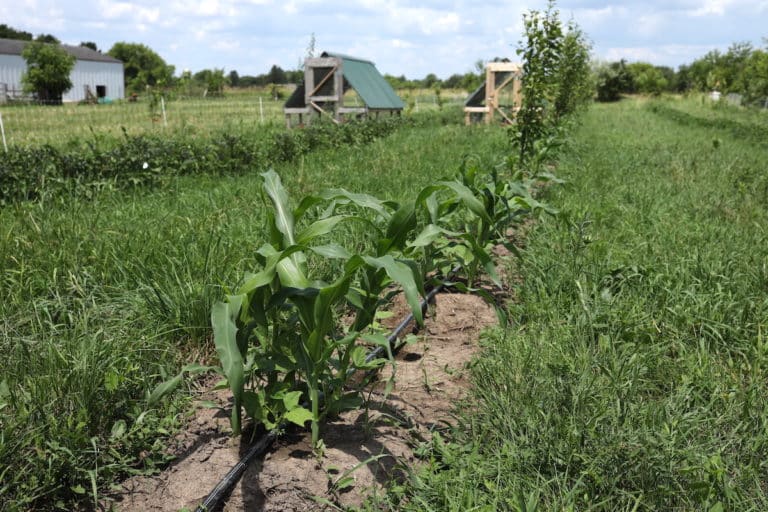Jug Waterer Review | Best Automatic Waterer For Farms And Homesteads
We are all about homesteading on a budget and making do with the bare essentials. But our Jug Waterer has become one of our favorite farm investments. In this post we’ll share how a Jug Waterer works, how they’re installed, and our honest review of their pros and cons.
Our Experience With Jug Waterers
We were introduced to Jug Waterers while working on a farm nestled far north in the driftless region of Wisconsin. The farm had a dual bowl Jug Waterer installed between two fenced pastures that had sheep, cows, llamas, alpacas, and donkeys in them all year round.
I was blown away by the concept of a heated, automatic waterer. Supplying water to animals in the winter can be one of the biggest headaches farmers and homesteaders face. But this nifty green contraption made it a breeze!

So, when we purchased our 5 acre homestead in 2019 and a used Jug Waterer came up for sale nearby, it was a no brainer. We brought Thimble, our family milk cow, and a calf onto the property. Then we installed our used Jug Waterer just before that first winter set in. Ever since, have enjoyed peace of mind and hassle-free water. Even on those really cold winter nights.
How does a Jug Waterer work?
Jug Waterers provide fresh, clean water to animals automatically and come in a few different options and configurations.
Jug Waterer models include:
- 101 – single drinking bowl
- 202 – dual drinking bowl
- 404 – four drinking bowls
Both the dual and four bowl models are ideal for installing along a fence line to give water access to animals in multiple pastures. The single drinking bowl unit is best suited for an individual pasture and smaller amounts of animals.
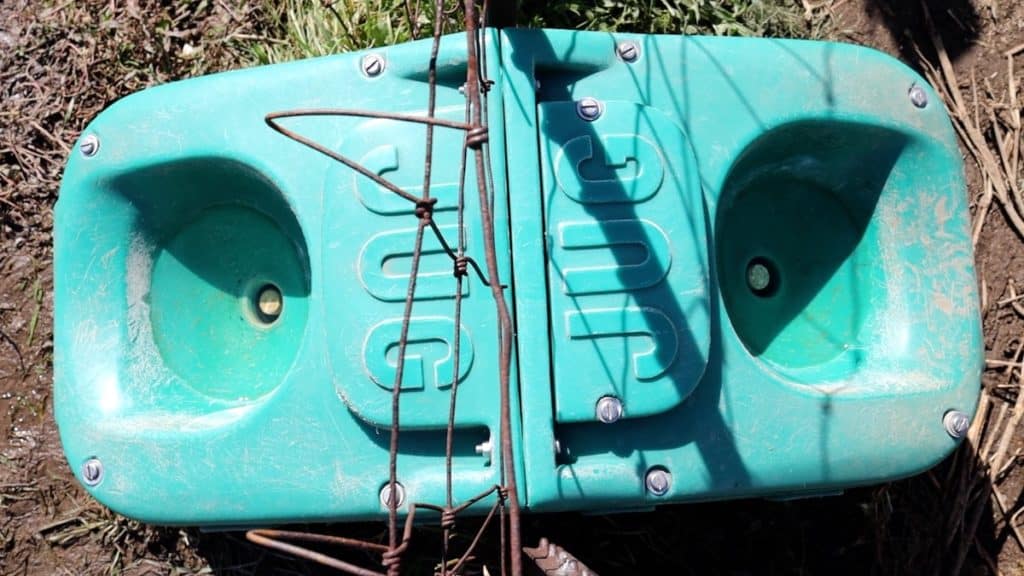
You can also get them with or without a built-in 65-watt heating element depending on your climate and the risk of water freezing.
But the primary heating for these units comes from the Earth Tube. This insulated tube is installed below ground and brings geothermal heat into the waterer.
The waterer itself is constructed of Jugs signature green plastic that is remarkably strong. The company describes it as “sledgehammer tough.” Which, when you think of a horn or hoof from a 2000 lb. steer, is the type of impact resistance you want.
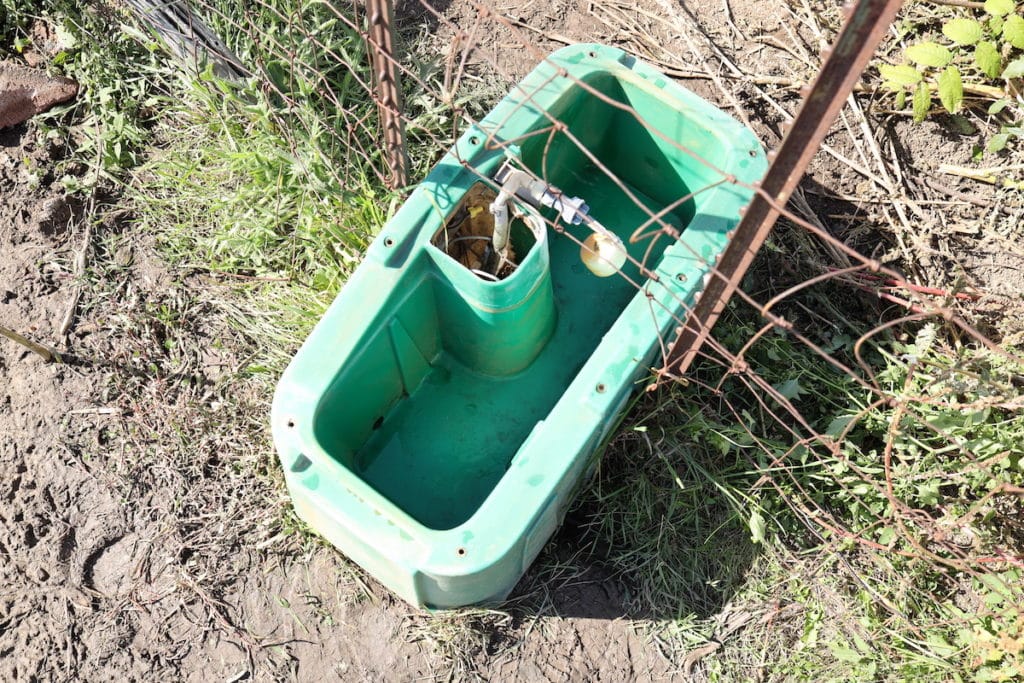
The unit’s plastic outer shell has a hollow core that is fully insulated with dense spray foam insulation to trap heat. There is also a seal between the water reservoir and top cover(s) to prevent heat and water transfer.
A float valve refills the waterer automatically. As animals drink, the float on the valve drops triggering it to refill the reservoir and water bowls. The water level never varies more than an inch or two. So your animals always have a fresh water supply on hand.
How are Jug Waterers installed?
I will start by saying that you should consult with or work with a Jug Waterer representative or dealer for for proper installation specs and techniques. Each installation will vary based on your farm and climate. For instance, more northern climates may require a deeper Earth Tube depending on the potential frost line.
But the typical install is to run your waterline and electrical (if the unit is heated) underground to the point where your waterer is installed. Depth should be below the frost line for your area.
Then you will dig in and install your Earth Tube and run the waterline and electrical up through it. I have heard of using a wide, thick-walled PVC pipe as a more affordable Earth Tube substitute. Note that this may impact the manufacturer’s guarantees or warranty.
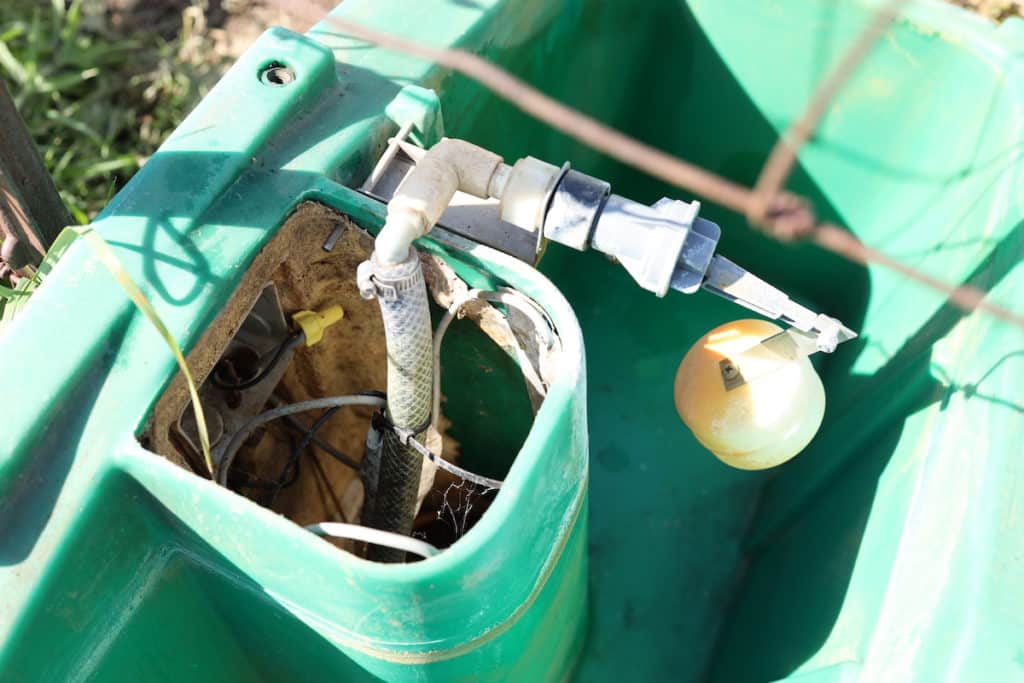
A concrete pad is then installed for the Jug Waterer to sit on. Four anchor bolts are placed are installed in the concrete at each corner of the unit. This provides a solid, secure surface once the waterer is bolted to the concrete.
After the waterline and electrical connections are made inside the unit, your Jug Waterer should be ready for action!
How we installed our Jug Waterer
Again, it’s best to follow the manufacturer recommendations and specs when it comes to installing these things. But sometimes desperate times call for desperate measures!
With winter quickly approaching that first year on our homestead, we found ourselves limited on both time and the proper equipment to bury a waterline 4’ down and run it to the location of our waterer.
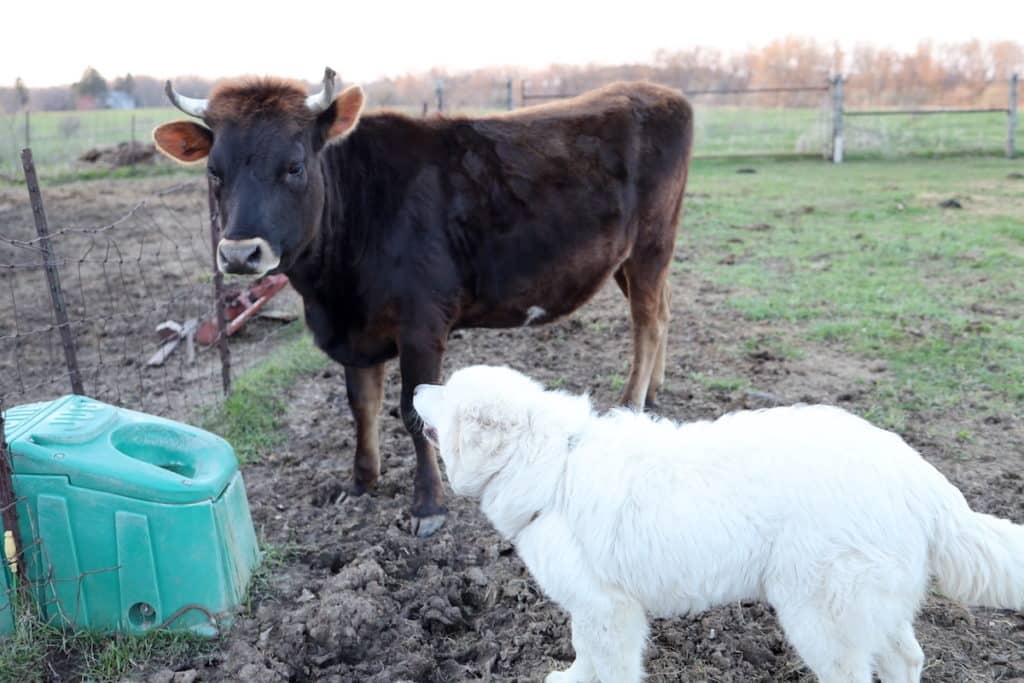
After some quick thinking, I discovered our local farm store carried heated hoses. I connected the heated hose to the hydrant in our barn, buried it only about 8” underground so no animals destroyed it, ran an extension cord along with it, and connected them up to our Jug Waterer that we installed between two fenced paddocks near our barn.
Keep in mind I also did not pour a concrete pad! The unit is just sitting on the ground with a couple of stakes pounded into the ground to secure the corners in place.
Amazingly enough, our Jug Waterer has worked perfectly for us for two winters in a row with this super janky (not Jug approved) setup!
Would I recommend this method? NO!!
But, if you find yourself in a pinch like we were, it may just be an option.
Jug Waterer Review
We are in no way affiliated with Jug Waterers and do not receive any financial incentive to promote their products. However, after using a Jug Waterer on our homestead and on a larger scale farm, we are believers in their product and freely share our honest review.
Here is our list of Pros and Cons.
Jug Waterer Pros
1. Keeps Water Clean
Jug Waterers have an ingenious component to them called the feed trap. The feed trap sits below the water bowl that animals drink out of. It traps all feed, hay, and other debris from entering the water reservoir. Fresh water is brought up to the drinking bowl through draw tubes that enter the feed trap.
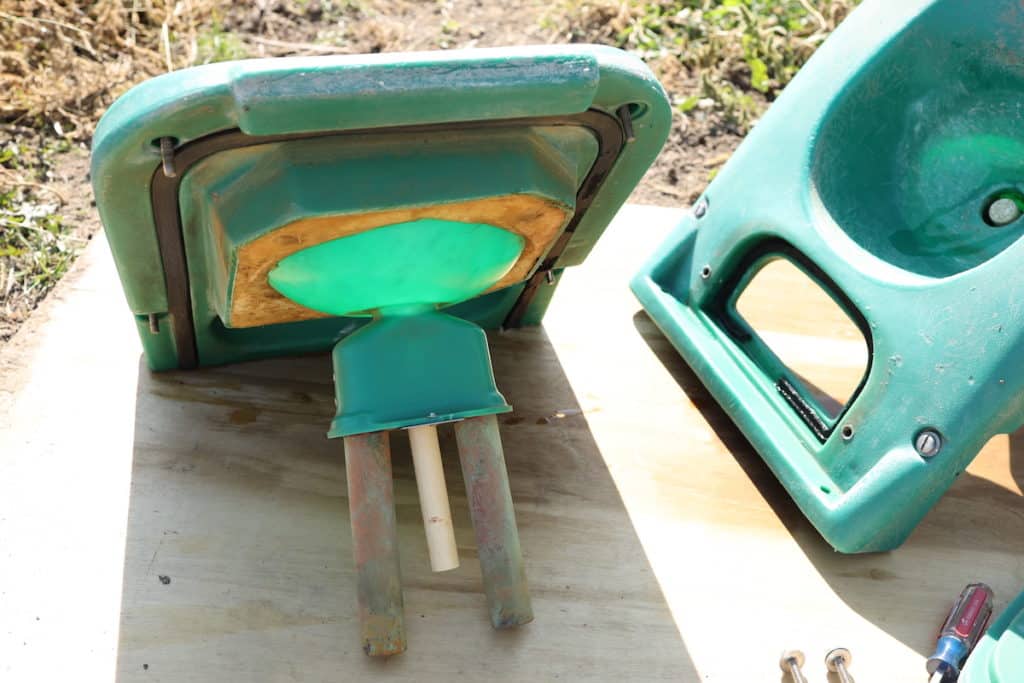
This feature, 1) prevents feed and debris from rotting and molding over time within your waterer, and 2) keeps algae from growing within your water.
Algae grows from sunlight exposure. Since the water reservoir is completely sealed off from sunlight, no algae growth occurs. With the absence of both algae and other debris entering the waterer, your animals have access to fresh, clean water all the time.
This, in my mind, is one of the most significant advantages that Jug has over other competitors out there. Many automatic waterers are open on top and can get gunked up quickly if not cleaned regularly.
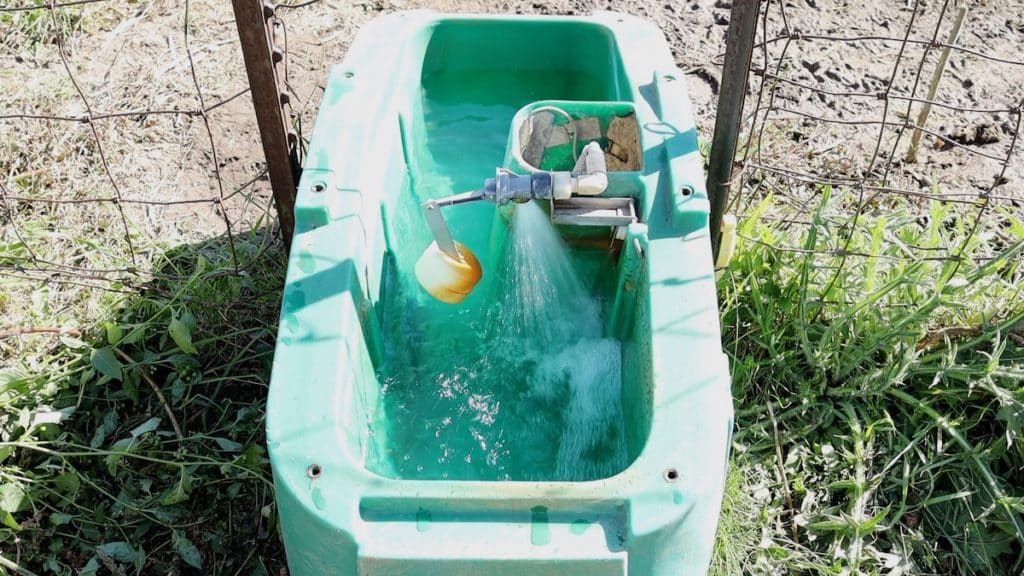
2. Works All Winter
We’ve had cold stretches here in northern Illinois and the farm we worked at up in Wisconsin had some really cold stretches. These Jug Waterers have stayed working and kept water from freezing through all of it.
Occasionally, on those REALLY cold days or nights, the water in the bowl will freeze up a bit. Just keep a screwdriver or hammer on hand, break up, and remove any ice, and you’re good to go. We generally check ours during morning and evening chores just to make sure nothing has frozen.
Evening is usually the time the bowl is most susceptible to freezing since the temps can drop and animals may go through longer periods without drinking. But as long as your animals use it regularly, it will rarely have ice form.
3. Easy To Clean or Service
You can do just about anything you need to on these units with only a flathead screwdriver!
The top cover has an access panel that pops off with just two screws and allows you to check the float valve. The float valve can easily be adjusted by turning a knob on the outside of the waterer with your screwdriver that raises or lowers the float position.
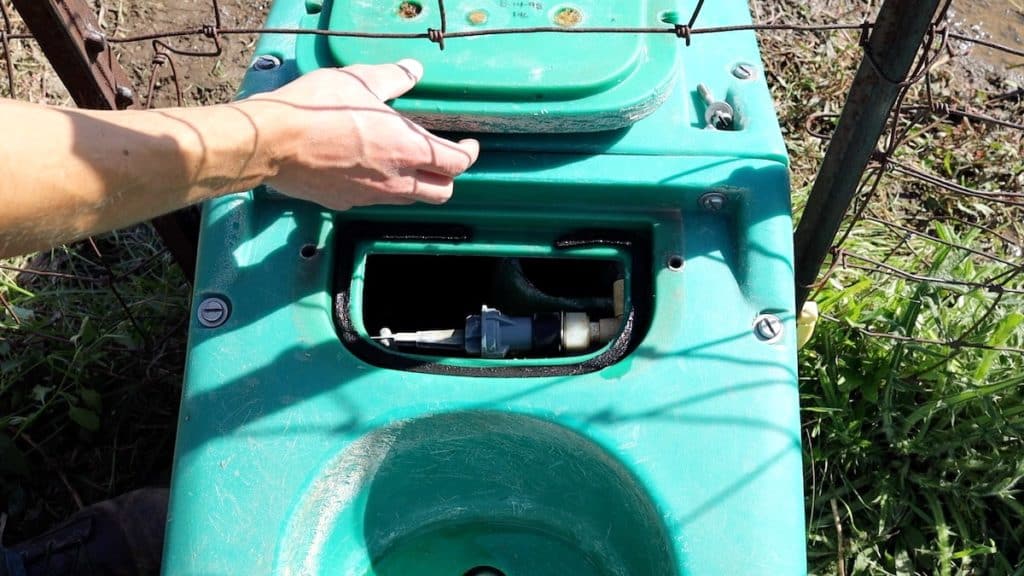
The top covers are fastened down with just a few stainless steel screws that can quickly be removed to pop off the cover. With the top open you can easily get in there with a brush and hose to clean the inside down. And a convenient drain plug at the bottom makes rinsing it out a breeze. Or draining it down when not in use.
For parts, there are very few things that can stop working and need replacement. The float valve is the same technology that’s in your toilet, and generally, those will last at least 10-20 years. The gasket that creates a seal between the cover and reservoir may need to be replaced every so often. And the heating element can also stop working over time.
Since we bought ours used, it is at least 10 years old, if not 15-20. It came from a commercial cattle farm, so it has seen some use and abuse. When we got it, the float valve was not working properly which was a quick and inexpensive fix. The gasket is also starting to deteriorate and will need replacing. And as far as I can tell, the original heating element is still in the unit.
4. Versatile
Because the water bowl sits about 1.5’ above the ground, Jugs can accommodate most any livestock or farm animals. Our cows and their calves have no problem using it. They are also suitable for horses, goats, sheep, llamas, alpacas, and donkeys and could also work for a larger pig. Our Livestock Guardian Dog has no problem using it and even our chickens enjoy cool, fresh water from it on occasion.
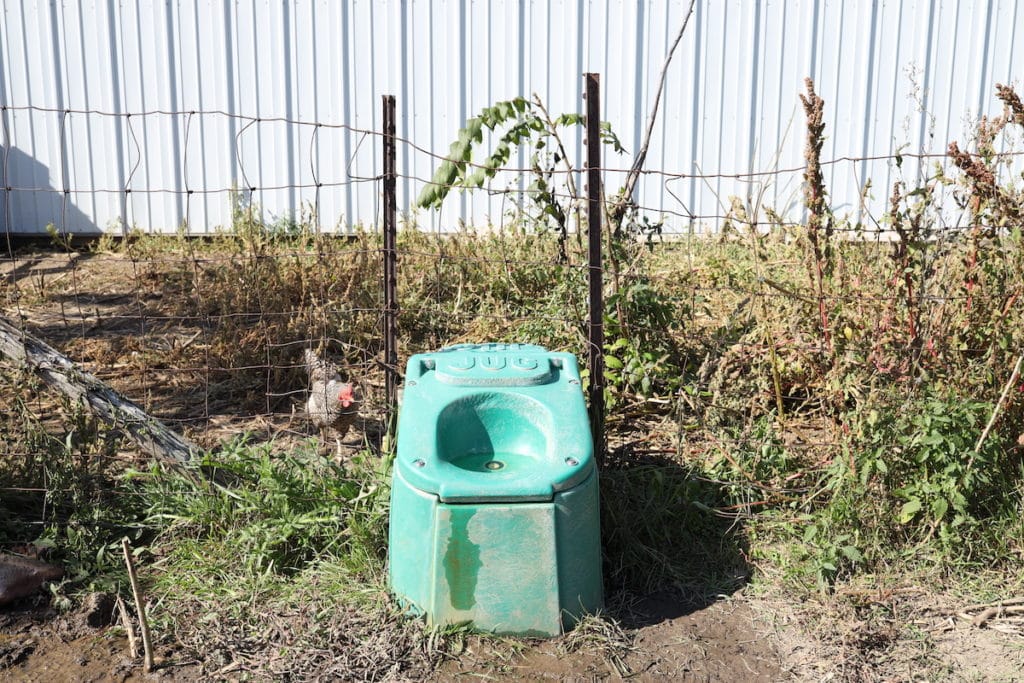
It is also versatile with herd size and acreage. I have seen them installed at many commercial farms with many acres and lots of animals. As long as you have the right-sized model for your application, a Jug should have no problem keeping a large herd of animals hydrated.
And, as is the case for us, I see a Jug Waterer as a useful and worthwhile investment for the homestead or small scale farm too. Often at this scale, the farm is not your sole career or source of income. You may spend the majority of your time at work away from the home, or just be busy with family life. Heck, you may even want to get away for a weekend or travel occasionally! Having an automatic source of water for your animals when you’re out and about or just busy can be a huge stress reliever!
5. Durable
Like I said, I got ours used from a commercial farm. I can only imagine what it’s been through in its decade or more of life!
You can tell from the outer shell it’s taken a beating. Animals gnaw on it. They get playful and jab it with their horns. It has stood up to all of this and still seems to have plenty of life left in it for years to come.
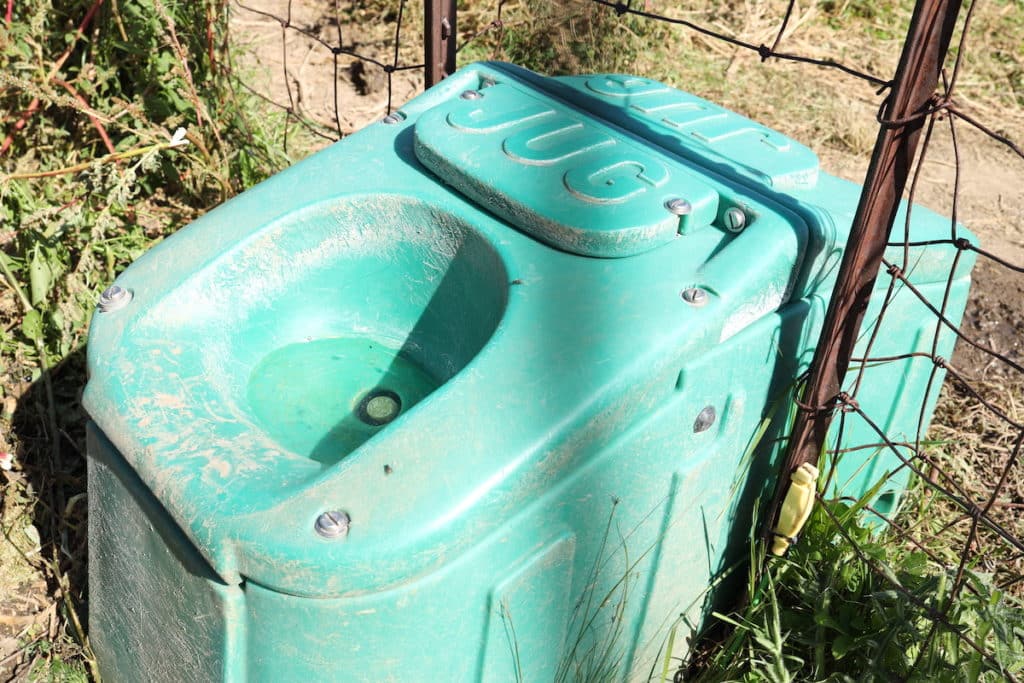
As with anything, parts wear out and will need to be replaced over time. But the unit itself is solid. That’s why Jug backs it with an industry-leading 15-year warranty. Obviously buying ours used I don’t have personal experience with the warranty. But I’ve heard from other owners that they back their product and stand behind their warranty.
6. Reliable
It all comes down to having something you can rely on in any and all circumstances. I have not seen a better product or design out there than what Jug offers on their automatic waterers. Anything you can throw at it – frigid and lengthy cold stretches, rowdy animals, a shotty install job – this waterer has just been dependable.
Jug Waterer Cons
1. Permanent Location
There is something to be said about the Joel Salatin approach of keeping everything on your farm portable. I like the portability of the water troughs we have. Even in the overwintering area where our Jug is currently installed, I’d have the flexibility with the water troughs to move them around so no one area gets trampled and torn up too much.
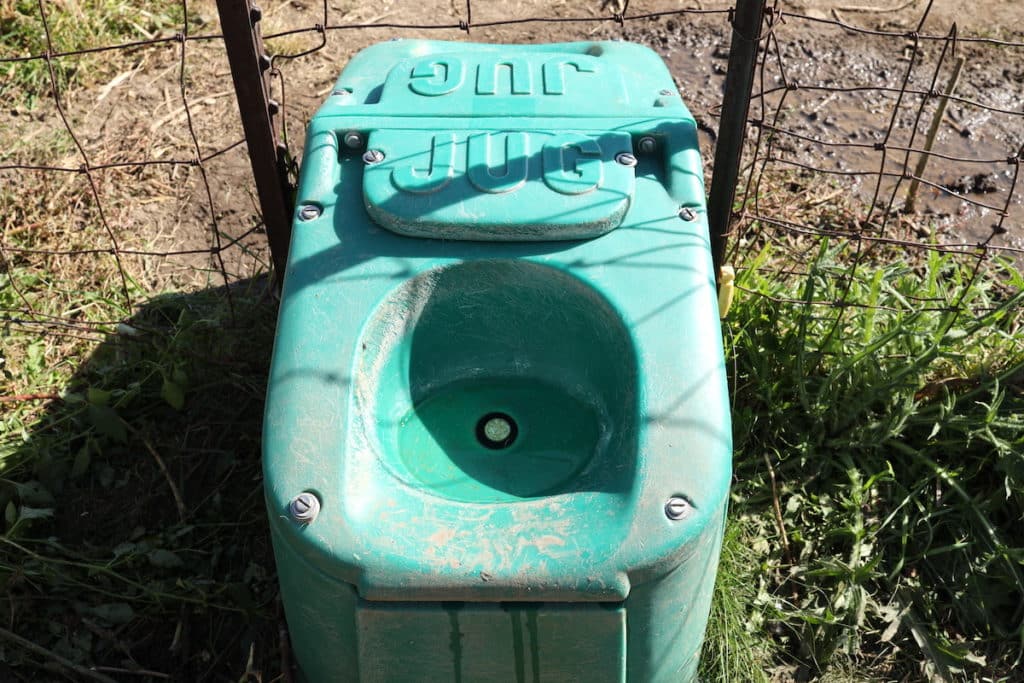
Once you run a water line, electrical, and pour your concrete base for your Jug Waterer, chances are you not going to relocate it any time soon. For that reason, you are best off accepting up front that the grass around your Jug will be sacrificed. Animals spend a lot of time near their source of water. Unless you are very vigilant about repairing and reseeding around it, there will likely be a sizable bare spot around your Jug that may just expand over time.
2. Keep It In Use
As with any water source, stagnant water isn’t a good thing. Our Jug is installed in our sacrifice or overwintering area. This works fine for the winter months when the animals are in those paddocks. However, when the grass is growing we have them on a back field, so the area with our Jug sits unoccupied.
We learned the hard way to remember to shut the waterline off and drain the unit when this is the case. The water, especially inside the drinking bowl and feed trap up top can get pretty nasty with algae and other deposits when sitting there.
Thankfully, it is really simple to shut the water off and drain the unit. And while cleaning inside all the cracks and crevices of the unit to get it up and running again can be a bit of a pain, it’s really not all that bad of job. The best thing to do is to just drain it and let it dry out when not in use!
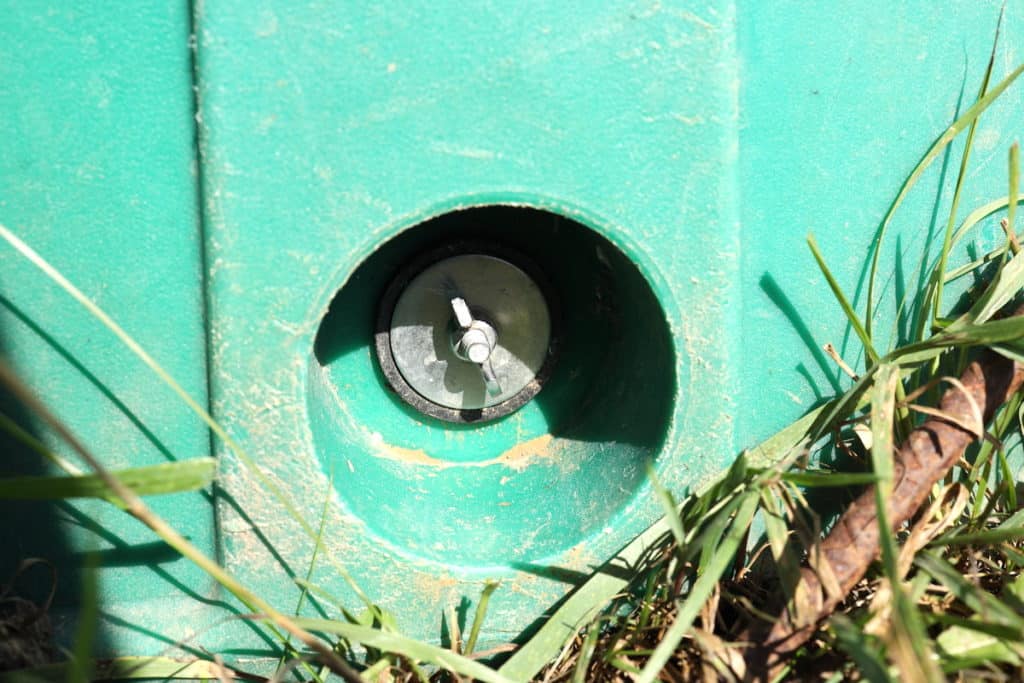
3. Cost
A Jug Waterer seems to run around $850 for the single 101 model and increases in price for the larger units. Plus, if installing on your own you may need to figure out renting equipment like a trencher or backhoe and purchasing other supplies. Having a professional install it will add labor costs.
When totaled up, it’s easy to see why the cost of a Jug Waterer may be prohibitive for some. There are certainly other less expensive options out there. We are grateful to have found a used Jug that made it much more affordable.
Some investments on your farm can be tricky to assign a real value to. For instance, you can buy a used 100-gallon water trough for around $50, pick up a submersible heater for maybe $50 more, run an electrical cord out there, and be all set for $100. But, unless you have a hydrant right next to the stock tank, have you figured out the time and energy of running 5-gallon buckets out there from the house or barn all winter long? That can be a significant cost in itself!
Water is a necessity on any farm. And it’s hard to assign a value to reliable clean, fresh water for your animals all year round. Yes, a Jug Waterer will carry a significant upfront investment. But consider your alternative system and multiply that over decades. Only you can decide what cost and investment is right for you.
Where can I find a Jug Waterer?
Their website – www.jugwaterers.com – will help you track down a dealer or representative in your area. You will want to work with them on the best installation setup for your climate to ensure it works as advertised.
You might also try the Bakko Industries website for a list of dealers or reps by state. When we lived in Wisconsin, the local plumber in town was a Jug Waterer dealer and installer. So you might also be able to contact a plumber in your locale for installation assistance.
Would we recommend a Jug Waterer?
Yes! No product is perfect, but I have been pretty darn impressed with the dependability of our Jug Waterer and how easy it is to clean and maintain. No gunky algae is taking over. Reliable water all winter long. And these units are built as solid as they come.
With no strings attached, we would hands down recommend you consider a Jug Waterer for your farm or homestead.
If you have additional questions OR experience using a Jug Waterer yourself, we’d love to hear from you in the comments below!
Get all the information you need on raising family milk cows:
- Owning A Family Milk Cow Basics
- What To Know About Rotational Grazing On A Small Scale
- Do Cows Get Cold? How To Keep Cows Warm In Winter
- How To Feed Round Hay Bales By Hand
Pin it for later!


